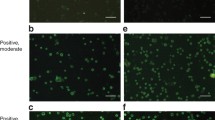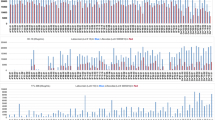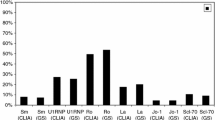Abstract
Typing for HLA-B27 is routinely performed in patients with seronegative spondarthritides. Besides the microlymphocytotoxic test (MLCT), other serological techniques have been developed such as enzyme immunoassays (EIA) using serum or plasma as a source for the determination of soluble HLA-B27 (sHLA-B27) and flow cytometric (FC) methods. The aim of the present study was to check the accuracy and reliability of the EIA for sHLA-B27 in comparison to the MLCT using antibodies against HLA-B27 and cross-reacting specificities (CRS), as well as an FC method and a molecular biological method. Any discrepant results should be typed with the MLCT using a complete panel of anti-HLA-class I antibodies, with FC and with a molecular biological technique. The EIA should also be repeated in those patients, using serum and plasma from a new venipuncture. In 81 patients with rheumatic disorders, the EIA and the MLCT using antibodies against HLA-B27 and CRS were performed. Based on the MLCT with a complete panel of anti-HLA-class I antibodies as a standard, discrepant test results were obtained for 9 out of 81 patients with the MLCT using antibodies against HLA-B27 and CRS and with the EIA. The following wrong results occurred: in the MLCT with anti-HLA-B27 and CRS, there were two false-negative results; in the EIA there were four false-negative and one false-positive results: one sample was undeterminable. In comparison with the MLCT, including the complete panel of HLA-class I antibodies, as well as with a molecular biological technique, typing with FC showed a complete concordance. Our investigations demonstrated that for routine typing for HLA-B27 the MLCT cannot be replaced by EIA because of a significant number of mistypings. The MLCT performed only with antibodies against HLA-B27 and CRS may also lead to typing errors. No errors were detected using flow cytometry. If only serological methods can be performed in a laboratory a combination of flow cytometry and MLCT could therefore enhance the safety of HLA-B27 typing.
Similar content being viewed by others
References
Calin A (1989) Ankylosing spondylitis. In: Kelley WN, Harris ED Jr, Ruddy S, Sledge CB (eds) Textbook of rheumatology. Saunders, Philadelphia, pp 1021–1052
Brewerton DA, Caffrey M, Hart FD, James DCO, Nicholls A, Sturrock RD (1973) Ankylosing spondylitis and HLA-B27. Lancet I:904–907
Schlosstein L, Terasaki PI, Bluestone R, Pearson CM (1973) High association of HL-A antigen, W27, with ankylosing spondylitis. N Engl J Med 288:704–706
Nickerson CL, Luthra HS, David CS (1990) Role of enterobacteria andHLA-B27 in spondyloarthropathies: studies with transgenic mice. Ann Rheum Dis 49:426–433
Gladman DD, Anhorn KAB, Schachter RK, Mervart H (1986) HLA antigens in psoriatic arthritis. J Rheumatol 13:586–592
Gladman DD, Brubacher B, Buskila D, Langevitz P, Farewell VT (1992) Psoriatic spondyloarthropathy in men and women: a clinical, radiographic, and HLA study. Clin Invest Med 15:371–375
Kellner H, Yu D (1992) The pathogenetic aspects of spondyloarthropathies from the point of view of HLA-B27. Rheumatol Int 12:121–127
López de Castro JA (1994) Structure, function, and disease association of HLA-B27. Curr Opin Rheumatol 6:371–377
Brand DL, Ray JG Jr, Hare DB, Kayhoe DE, McClelland JD (1970) Preliminary trials toward standardization of leucocyte typing. In: Terasaki PI (ed) Histocompatibility testing 1970. Munksgaard, Copenhagen, pp 357–367
Albrecht J, Müller HAG (1987) HLA-B27 typing by use of flow cytofluorometry. Clin Chem 33:1619–1623
Janssen WCM, Rouwen JACN, Hoffmann JJML (1992) Improved flow cytometric method for HLA-B27 typing. Ann Clin Biochem 29:663–667
Ax W (1991) Das HLA System: 1327 Typisierung mit Hilfe der Flow-Zytometrie. Klin Lab 9:267
Orr K, Thomson GTD, Alfa M (1994) Utilization of commercial antisera and flow cytometry in HLA-B27 typing. Cytometry 18:17–20
Hulstaert F, Albrecht J, Hannet I, Lancaster P, Buchner L, Kunz J, Falkenrodt A, Tongio M, De Keyser F, Veys EM, Noens L, Mir N, Costello C, Becker R, Strauss K (1994) An optimized method for routine HLA-B27 screening using flow cytometry. Cytometry 18:21–29
Doxiadis I, Westhoff U, Grosse-Wilde H (1989) Quantification of soluble HLA class I gene products by an enzyme linked immunosorbent assay. Blut 59:449–454
Samoso S, Kiefel V, Volz H, Mueller-Eckhardt C (1992) Quantitation of soluble HLA class I antigen in human albumin and immunoglobulin preparations for intravenous use by solid-phase immunoassay. Vox Sang 62:29–33
Chang CH, Ferrone S, Pouletty P (1991) sHLA-STAT B27. An ELISA for HLA typing using serum. Hum Immunol 32 [Suppl 1]:289
Huetz F, Lucotte G, Kahan A, Amor B (1987) Polymorphisme de restriction Taq I et allèle HLA B27 dans la spondylarthrite ankylosante. Rev Rhum 54:175–178
Ness DB, Grumet FC (1987) New polymorphisms of HLA-B27 and other B locus antigens detected by RFLP using a locus-specific probe. Hum Immunol 18:65–73
Steffens-Nakken HM, Zwart G, van den Bergh FAJTM (1995) Validation of allele-specific polymerase chain reaction for DNA typing of HLA-B27. Clin Chem 41:687–692
Olerup O (1994) HLA-B27 typing by group-specific PCR amplification. Tissue Antigens 43:253–256
Middleton D, Williams F, Cullen C, Mallon E (1995) Modification of an HLA-B PCR-SSOP typing system leading to improved allele determination. Tissue Antigens 45:232–236
Lôpez-Larrea C, Sujirachato K, Mehra NK, Chiewsilp P, Isarangkura D, Kanga U, Dominguez O, Coto E, Pena M, Setién F, Gonzalez-Roces S (1995) HLA-B27 subtypes in Asian patients with ankylosing spondylitis. Tissue Antigens 45:169–176
Pouletty P, Chang C, Kalil J, Atwood E, Ferrone S, Shimizu B, Howson W, Mazaheri R, Del Villano B, Grumet C (1993) Typing of serum-soluble HLA-B27 antigen by ELISA. Tissue Antigens 42:14–19
Miller SA, Dykes DD, Polesky HF (1988) A simple salting out procedure for extracting DNA from human nucleated cells. Nucleic Acids Res 16:1215
Craxton M (1991) Linear amplification sequencing, a powerful method for sequencing. Methods: a companion to Methods Enzymol 3:20–26
Fischer GF, Faé I, Petrasek M, Haas H, Mayr WR (1995) An HLA-DR I I variant (HLA-DRB 1 * 1115) segregating in a family of Turkish origin. Tissue Antigens 45:145–147
Neumüller J, Fischer M, Ebert R (1993) Failure of the serological determination of HLA-B27 due to antigen masking in patients with ankylosing spondylitis. Rheumatol Int 13:163–167
Krangel MS (1986) Secretion of HLA-A and -13 antigens via an alternative RNA splicing pathway. J Exp Med 163:1173–1190
Krangel MS (1987) Two forms of HLA class I molecules in human plasma. Hum Immunol 20:155–165
Dobbe LME, Stam NJ, Neefjes JJ, Giphart MJ (1988) Biochemical complexitiy of serum HLA class I molecules. Immunogenetics 27:203–210
Grosse-Wilde H, Doxiadis I (1989) Allotyping for HLA class I using plasma as antigen source. J Immunogenet 16:149–155
Grumet FC, Buelow R, Grosse-Wilde H, Kubens B, Garovoy M, Pouletty P (1994) Report of the second international soluble HLA (sHLA) workshop. Hum Immunol 40:153–160
Zavazava N, Wobst B, Ferstl R, Müller-Ruchholtz W (1994) Soluble MHC class I molecules in human body fluids. J Clin Lab Anal8:432–436
Ferrone S, Yamamura M, Grosse-Wilde H, Pouletty P (1992) W14.1 Summary of the serum-soluble HLA class I antigen component. In: Tsuji K, Aizawa M, Sasazuki T (eds) HLA 1991. Oxford University Press, Oxford, pp 1057–1061
Puppo F, Scudeletti M, Indiveri F, Ferrone S (1995) Serum HLA class I antigens: markers and modulators of an immune respone? Immunol Today 16:124–127
Tsuchiya N, Husby G, Williams RC Jr (1989) Studies of humoral and cell-mediated immunity to peptides shared by HLA-27.1 Klebsiella pneumoniae nitrogenase in ankylosing spondylitis. Clin Exp Immunol 76:354–360
Toubert A, Hamachi M, Raffoux C, Park MS, Yu DTY (1990) Epitope mapping of an HLA-B27 monoclonal antibody that also reacts with a 35-kD bacterial outer-membrane protein. Clin Exp Immunol 82:16–20
Groß U, Chen J-H, Kono DH, Yu DTY (1990) A ribosomal protein ofYersinia pseudotuberculosis having partial epitope identity with HLA-B27. Autoimmunity 7:267–277
Russo C, Fotino M, Carbonara A, Ferrone S (1987) A double determinant immunoassay for HLA class I typing using serum as an antigen source. Hum Immunol 19:69–77
Author information
Authors and Affiliations
Rights and permissions
About this article
Cite this article
Dunky, A., Neumüller, J., Hübner, C. et al. HLA-B27 determination using serological methods. A comparison of enzyme immunoassay and a microlymphocytotoxic test with flow cytometry and a molecular biological assay. Rheumatol Int 16, 95–100 (1996). https://doi.org/10.1007/BF01409980
Received:
Accepted:
Issue Date:
DOI: https://doi.org/10.1007/BF01409980




